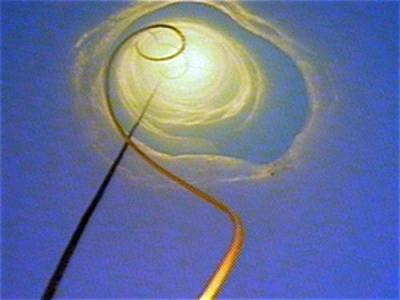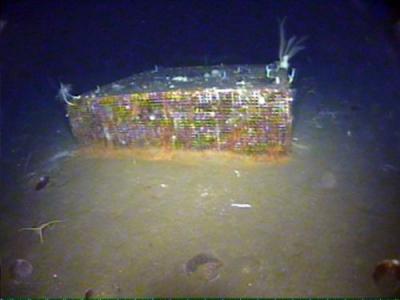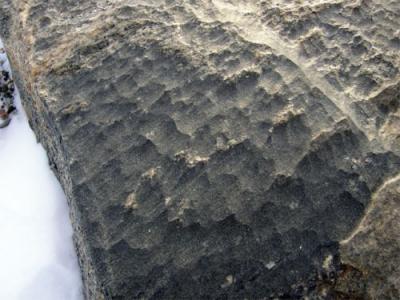"The McMurdo Dry Valleys contain cold desert soils millions of years old, unusual biological communities, special geological features and minerals and spectacular scenery.” From the McMurdo Dry Valleys Antarctic Specially Managed Area (ASMA) Manual.
Today we woke up to strong winds. None of us wanted to go outside and work, but Stacy and Marcus headed out to get ready for VideoRay's big day at the dive site called "Circus". Stacy radioed the rest of us in the Jamesway for help. One by one we slowly blew out the door to help.
Speaking of blowing out doors, look at the carpenters' fine work on the inside of the outhouse door. When the easterly winds blow, you have to pull on the webbing to shut the door!

Outhouse door handle, webbing and lock
We drilled the last of the transducer holes (yahoo!) and packed up the Jiffy Drill and flights. Overall, at New Harbor, we drilled over 100 flights of ice. My arm hurts just thinking about it!
I took a short break to record wind speeds. They had slowed down to about 20 feet per second. My Chemistry students should be able to convert that to miles per hour:
20 feet/second x 1 mile/5280 feet x 60 seconds/minute x 60 minutes/hour = # miles/hour (Answer at bottom of post!)

Recording wind speeds with a small anenometer
Inside the Polar Palace, Marcus was now flying VideoRay underwater at Circus, Nick was getting successful navigation data, and Stacy was hand-drawing a map (just in case navigation was off) and making notes on the structures they found underwater. They mapped over 50 sites! Remember, many of these were put down in 1967 by Dr. Paul Dayton and hadn't been seen in 40 years!

Stacy, Marcus and Nick flying VideoRay from the Polar Palace

Image from VideoRay of the hole it came through
In this photo, you are looking up from the ocean through the hole in the sea ice. The yellow cable is the tether cable that carries power and information to and from VideoRay to the computer. The black cable is one of the three transducer cables used for the triangular navigation system. To read how this works, go to Stacy's post here.
Stacy is finding that the floating structures that remain upright (off the sea floor) have large sponges on them.

Floating structure with large sponges on it
The structures that have fallen down don't have the living sponges. Notice the predatory starfish on this large sponge it has killed on the downed "floater".

Downed floater with predatory starfish on dead sponge
Notice the two laser points on the dead sponge showing its size. The lasers are 3.06 inches (7.8 cm) apart. How large is the dead sponge? The spindly leg creatures are called brittle stars and are related to starfish.
Besides floating structures, Dr. Dayton also put down exclusion cages. The cages keep out large organisms and only small ones can get inside, so you can see how that affects what is able to grow in an area.

Exclusion cage on the seafloor
For a control, Dr. Dayton put down cages where the top was off so we can see the difference in the organisms in each situation.

Cage that is left open as a control
While Stacy, Marcus and Nick were warm and snug in the Polar Palace, Bob rounded up Bryan and I to try and retrieve the stuck flights.

Bob in the hole with the stuck flights
We dug the hole out large enough that Bob could get down and unscrew the top two flights, but we were unable to retrieve the lower four flights. We flagged the site and tied the remaining flights to the ice in hopes they can be retrieved later in the season if the ice starts to break up.

Bob took this picture of Bryan and I from down in the hole
By the time we finished dinner and dishes it was 11 p.m. But we are coming close to the end of our time at New Harbor so we went for a walk just up the valley from camp. Because this is a specially-managed area, we walked in each other's footsteps whenever we were off the snow to minimize any human impacts.

Sorted pebbles on top of finer sediments below
The surface is covered with pebbles that can't blow away as easily as the sand and silt that is just under them. The larger pebbles may have worked to the top by freeze-thaw cycles and the silt and sand get blown off by the strong winds.
In similar Arctic landscapes, this ground would be "permafrost", permanently frozen soil underneath. But in the Dry Valleys, there is no water or ice to bind the soil particles together; every footprint disturbs the ground.

Ice-rafted boulders have angular features
While it looked like we were on a moraine crest left by a glacier, there were no rounded boulders like glaciers leave behind. Instead, the large boulders were all angular. They were probably ice-rafted in and so didn't tumble around and become rounded.

Boulder showing ventifacts
Many of the boulders also show "ventifacts", facets created by the strong winds. If you are familiar with "stoss and lee" features from your geology classes, these are similar and show the predominant strong wind directions.
We got home in time for dessert at 1 a.m. and then collapsed, both exhilarated and exhausted, into our sleeping bags.
Answer to Wind Speed: 13.6 miles per hour

